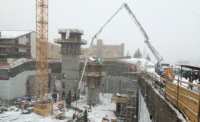Two harbor seals glided lazily through the water, glancing at the handful of construction workers putting the finishing touches on the new $18-million Rocky Shores exhibit at Utah's Hogle Zoo.
Several weeks before the scheduled June 1 opening, the seals were getting accustomed to their new home, while Rizzo, the 14-year-old female polar bear from the Cincinnati Zoo, and three brown bears remained in quarantine a few more days before moving into their new enclosures.
Workers from South Jordan, Utah-based Sirq Construction have just completed work on a project that has taken nearly two years to build and many more to plan. Rocky Shores is the third of four new "anchor attractions" at the zoo built with funds from a taxpayer-approved bond as well as private donations. It showcases not only harbor seals but also eagles, river otters and sea lions and marks the return of bears to the zoo.
Rocky Shores occupies about 3.5 acres on the zoo's northwest end and includes three separate habitats and five water features, including both saltwater and freshwater habitats. The site was previously occupied by brown bear and polar bear exhibits constructed in the 1950s but demolished to make room for the new exhibit, says Doug Lund, assistant administrator for the zoo.
"We decided nine years ago, when we last had a polar bear here, we were not going to have them back until we could create a really top-of-the-line habitat," Lund says. "The old bear grottoes were just not up to current standards."
Built on a sloping site next to a canyon stream, Rocky Shores is designed to resemble a cannery or shipping dock on the northwest coast of the U.S., says Jon Stefansson, the project architect from Philadelphia-based CLR Design. "We used elements like corrugated metal, sheet metal and steel beams. Those are durable materials but also have a rawness that seemed appropriate," he says.
Lund says the site in the Wasatch foothills presented advantages as well as challenges. "We don't have room here to expand, so we have to take advantage of the terrain we have," he says. "It worked for us because many zoos on flat land end up building terrain, but we already have the land forms here to work with. We also gave a lot consideration to the mountain views behind the exhibits and how the sun will affect viewing and the habitats."
Lund says the significant sitework included installing a new bridge over Emigration Creek as well as piling and shoring near the creek. A 16-ft-deep moat, part of the brown bear enclosure, required construction of an angled gabion wall secured with geofabric and coated with shotcrete. The exhibit space utilized 1,300 cu yd of shotcrete to create the rugged finishes designers wanted, he says.
"We have some challenging soils here with limited bearing pressures," Lund says. "Putting in a conventional retaining wall proved to be very expensive, and the footing would have been too large for our space. Using the mechanically stabilized earth proved much less expensive, and it worked very well for what we needed."
Water Works
Processing and circulating the hundreds of thousands of gallons of water needed for the exhibit was the major engineering challenge for the team, Lund says.
"From the bottom of some of our holding tanks to the upper pools we have an elevation change of about 50 feet in a short distance," he says. "We also had to fit an extensive pipe network in here. We've got the sewer, potable water, gas and electrical supply lines and life-support pipes going to the pools. Some of them are 16-inch-diameter pipes, and it all had to be buried 15 to 16 feet down. We used HDPE (high-density polyethylene) piping for most of it because it should last longer."
According to Sirq's Jason Kirkham, the project included around 8,000 linear ft of utility pipe, including 3,000 linear ft of HDPE pipe and 1,000 linear ft of PVC pipe for the water system.









